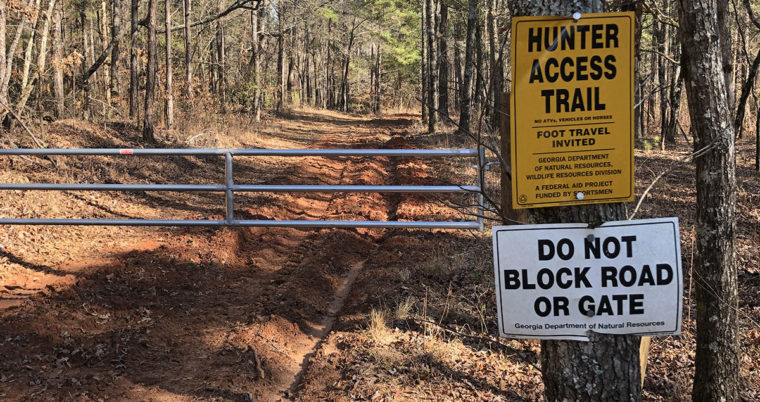For me, one of the primary draws to public-land hunting is the freedom it provides to roam large tracts of land at a minimal cost. If one area doesn’t produce, I have seemingly unlimited opportunities to change locations and hunt a fresh spot. As great as it is to have that freedom to roam, approaching a large block of land for the first time can be a daunting task. It could take years to familiarize yourself with every acre of a new area, but fortunately you don’t have to! By using online resources available to deer hunters today, you can eliminate the need to scout a large portion of that land without leaving your house. And by focusing your efforts on the high-percentage areas that are left when you do put boots-on-the-ground, you’ll be more efficient and likely much more successful. If you’re a private-land hunter, don’t close your browser window just yet. These same tactics will work just as well on large tracts of private land.
My first real public land hunting experience was at Land Between the Lakes National Recreational Area (LBL) in western Kentucky. LBL is 170,000 acres of public land, with over 95% of that being in mature timber; talk about intimidating. I was initially overwhelmed with where to begin my scouting efforts, but decided to approach it the same way you would approach eating an elephant: one bite at a time. I started by picking a somewhat random block of around 600 acres, and focused on learning everything I could about that block. And while I don’t think that’s a bad approach for hunting a large tract of public land, I no longer feel it’s the best way. The problem with the “pick a block” approach is that the entire block may not hold the quantity or quality of deer you are after, or it may hold some good pockets to hunt, but someone else may already be hunting them. By putting all your eggs in one basket, so to speak, you aren’t left with any backup options if you get in there and don’t find the sign or the deer you are after.
While old sign will tell you where the deer were, which may be useful at different stages of deer season, always focus your in-season scouting efforts on fresh sign. You want to hunt where the deer are, not where they were or where you hope they’ll be.
Over the next 20-plus years of hunting public land and managing it for two state wildlife agencies, my scouting methods evolved. More recently, I’ve really started studying some of the more successful public land hunters and have even interviewed several on a podcast that I host. What I’ve learned is that most of these hunters take a broader approach to learning a large tract of public land.
So now, instead of picking one smaller block, I look at the entire property and try to quickly eliminate areas where the odds of intercepting a mature buck seem lowest — places with easy access, or obvious draws for other hunters like food plots or nice open oak ridges — and focus on areas where I can get away from the crowds. By doing so, you can quickly narrow down potential spots to a handful of locations, and then use boots-on-the-ground scouting to really hone in on exact stand locations. Let’s take a look at how you can begin breaking down a large tract of hunting land to put the odds in your favor this season.
Cyber Scouting
The first step I’m going to take when approaching a new property is to sit down with my laptop computer and use the onX website to cyber scout. Cyber scouting, or digital scouting as it is sometimes called, is simply using online resources like aerial photos and topographic maps to look for places that may concentrate deer and to eliminate places that concentrate hunters. I prefer using onX because I can scout and mark locations on my laptop, and when I get to the field to put boots on the ground, I can open the onX app and have all my information right at my fingertips, even without a cell signal. I also like the ability to overlay topographic lines on aerial photography to get a really good feel for the terrain and habitat on the property without having to switch back and forth between two maps.
NOTE: If you’re interested in trying out onX, you can get 20% off any Premium or Elite membership by using the promo code QDMA at onxmaps.com.
Get Away From the Crowd
The primary point to keep in mind while cyber scouting is that decades of deer research has repeatedly shown deer like to be in areas where hunters don’t go. This is particularly true when it comes to mature bucks. Hunters who consistently kill mature bucks on public land tend to be the ones who focus on these out-of-the way areas that are difficult to access, whether due to being remote, having inhospitable habitat (think thick, nasty briars or swamps) or consisting of rough or overly steep terrain. And since these types of areas are where mature bucks feel most comfortable, that is exactly what I try to locate when I’m scouting. Specifically I am looking for areas that require a long walk without the benefit of a road or trail, areas that require the use of hip waders or even a boat to access, or areas that may simply get overlooked due to their size, location, or lack of parking access.
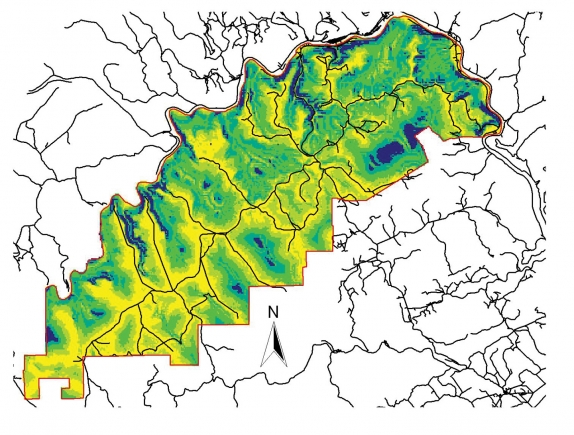
The results of a Penn State University study on hunting pressure conducted on a Pennsylvania state forest are shown in the map above. The yellow areas represent the highest density of hunters recorded. The dark blue areas saw essentially no hunting pressure.
QDMA has shared research in the past conducted by Penn State University that looked at how deer hunters dispersed themselves on a large tract of Pennsylvania state forest. In a nutshell, the 2002 research showed that the vast majority of these hunters hunted within 1/3 of a mile from a forest road. I would love to see a similar study conducted in 2020, because I believe you’d see a slight shift in behavior by today’s public land hunters. It seems that with the rise in popularity of public land hunting and the ability to use most any smartphone as a feature-rich GPS unit, more hunters are willing to venture further from their vehicles these days. However, despite that willingness to walk longer distances, most still seem reluctant to get very far off the beaten path. They’ll follow closed roads and trails for miles, but very few will stray far from them.
Water Access
Another method to get away from the crowd that seems to be gaining in popularity is the use of water access. That can range from using hip waders to cross a creek or navigate a swamp to using a kayak or canoe to reach otherwise inaccessible block of public land. If you follow The Hunting Public on YouTube, you have undoubtedly seen them use boat access successfully on numerous occasions. Another public land Hunting Beast, Dan Infalt, is notorious for trekking long distances through Wisconsin’s swamps in search of mature whitetail bucks, and he’s had plenty of success to show for it. And while I’m personally new to the whole water access technique, I’ve set a goal to make 2020 the year I finally get to paddle a public land deer back to my truck in my kayak.
So if you’re scouting a new tract of public land, don’t overlook any water features that may provide a means for getting away from the crowd. Mark them on your mapping app, and be prepared to check them out when you finally do your in-person scouting.
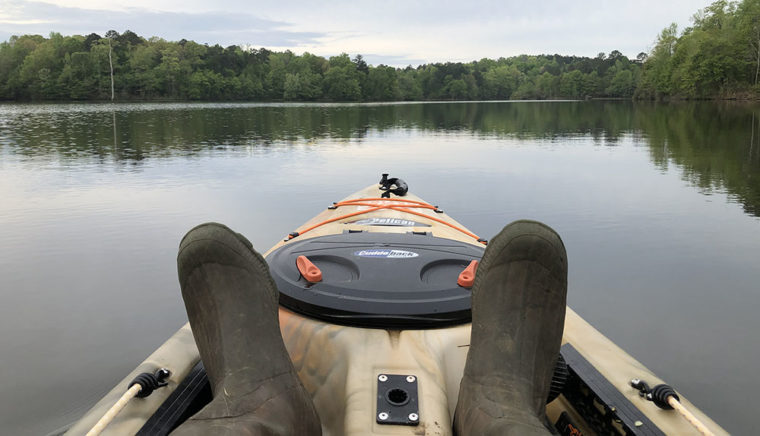
Using a canoe or kayak to access otherwise unreachable or difficult-to-access blocks of public land can be a great way to find un-pressured or lightly pressured deer.
Overlooked Areas
In some instances, a low-pressured spot may not require a long walk or water access. It may simply be an area that gets overlooked due to its size, location, or lack of parking access. I saw this a lot while working as a wildlife technician on a heavily pressured WMA in Kentucky. Hunters seemed to naturally gravitate to the larger, easy access blocks and often overlooked some of the smaller access points that required a considerably longer drive to reach. I’ve also seen sizable tracts of public land along a highway or county road get overlooked due to the lack of any designated parking areas. Keep these types of places in mind as you study aerial photos and topographic maps. That small, out-of-the-way block may just be your ticket to an un-pressured, or under-pressured, deer.

Long Stretches of Road through a tract of public land with no designated parking areas, like the one seen here on a Wildlife Management Area the author frequents, can often provide access to an overlooked area. You can simply pull onto the shoulder when possible, have someone drop you off, or park at the nearest parking access and walk the road to where you want to enter the woods.
Find the Edge
Once I’ve blocked off numerous potential spots based on what I feel will be low hunting pressure, I then start to look closer within each of those blocks for favorable habitat and terrain features that I believe will concentrate deer or funnel deer movement.
Since deer are creatures of edge — meaning they like to hang out in areas where two or more habitat types meet — that is exactly what I’m focused on finding within the low-pressured blocks I picked out in the previous step. Edge habitat can come in numerous forms, including where a clear cut meets mature hardwoods, or where a thinned pine stand meets hardwoods, or where a fallow field or agriculture meets a hardwood bottom. Where I am in the Deep South, the most prominent edge habitat occurs where planted pines meet hardwood drainages, often referred to as SMZs or streamside management zones, or in areas where pine stands of different age classes meet.
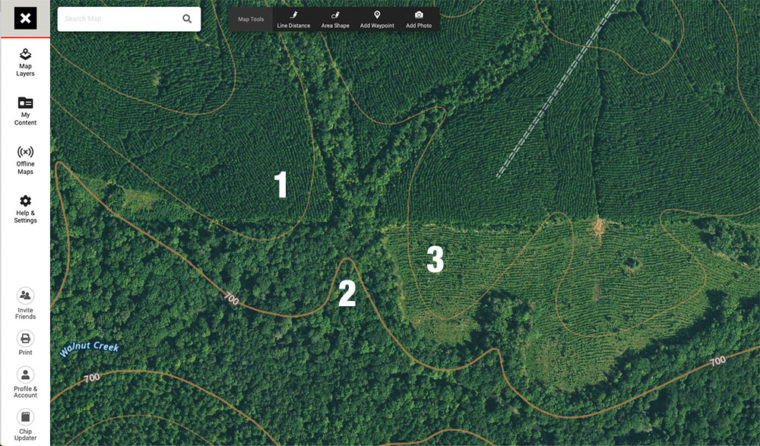
Since deer love edge habitat, where two or more habitat types meet, that is where the author focuses his attention after locating some out-of-the-way locations. In this case, you have at least three different vegetation types converging, with #1 and #3 likely providing excellent cover.
I love finding places with three or more vegetation types within close proximity, and if one of those provides thick cover like a recent clearcut or young pine stand, even better. Good cover is essential to making a mature buck feel more comfortable moving during daylight hours, and hunting that thick cover is a common thread among successful public land hunters I have interviewed. That’s why everything I look for once I put boots on the ground — whether it’s food sources, rubs, scrapes, or deer tracks and droppings — I’m looking for in close proximity to good cover. Otherwise, that sign is likely being made at night.
Terrain Features That Concentrate Deer
In addition to good edge habitat, I’m also looking heavily at terrain features that may concentrate deer or funnel deer movement. How important these features are to your success is going to depend heavily on what part of the country you hunt. In rugged, mountainous regions, terrain is going to have a much greater influence on deer movement than in flatter parts of the Midwest and Deep South. Like humans, deer seem to prefer the path of lease resistance when possible, so features like saddles, crow’s feet (see image above), bluffs, rivers and lakes can all funnel deer movement, creating a perfect setup to ambush a deer. Some of these features can easily be picked out on topographic maps, while others may be more subtle and require experience and boot-on-the-ground scouting.
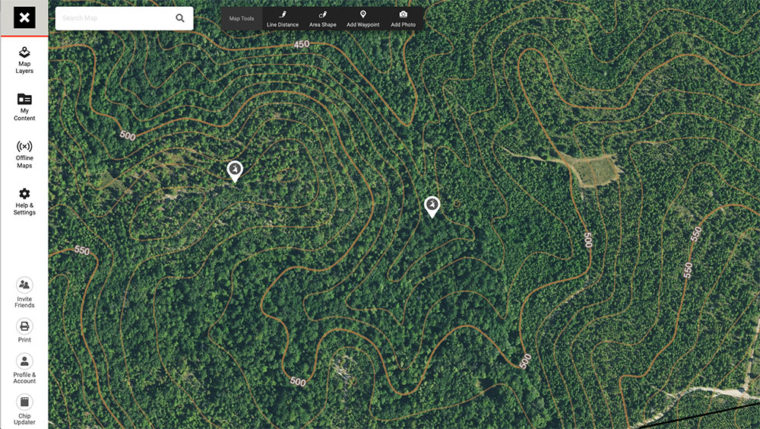
Since deer love edge habitat, where two or more habitat types meet, that is where the author focuses his attention after locating some out-of-the-way locations. In this case, you have at least three different vegetation types converging, with #1 and #3 likely providing excellent cover.
Time to Put Boots on the Ground
Once you’ve worked through the process of looking for out-of-the-way areas with good edge habitat and favorable terrain features, hopefully you will have numerous spots marked that hold excellent potential for the upcoming season. Now it’s time to get in the field and put eyeballs on those spots to see if they look as good in person as they did on your computer.
Once in the field, I’m not only using onX to navigate to these areas, but I’m also using it to mark everything I find along the way, including trails, rubs and scrapes, deer beds or potential bedding locations, potential food sources, as well as any hunter sign. My goal during these scouting sessions is to cover as much ground as I can. The time I spend on any one particular area is going to be dependent on the sign I’m finding. If it’s a great area that really shows promise, I’ll spend more time there trying to get an idea of what the deer are doing — where they are bedding, food sources, travel patterns, as well as how I would access the spot and which tree I would hunt from.
While old sign will tell you where the deer were, which may be useful at different stages of deer season, always focus your in-season scouting efforts on fresh sign. You want to hunt where the deer are, not where they were or where you hope they’ll be. Regardless of how good the spot looked on onX, if the sign isn’t there, keep moving. Cyber-scouting just gives you the starting point, but your in-person scouting is key to pinpointing actual stand locations.
Scouting a large block of public land is a process, and not something you’ll do once and be done. If your efforts don’t pay off the first season, don’t think of it as failure. You have to play the long game. I learn so much each and every season, whether they end in a filled buck tag or not. Just remember that each year’s efforts build on years past until you eventually start to have a much better understanding of the entire property — which spots produce and which don’t. In the end, you’ll be a more knowledgable and successful deer hunter for your efforts.
